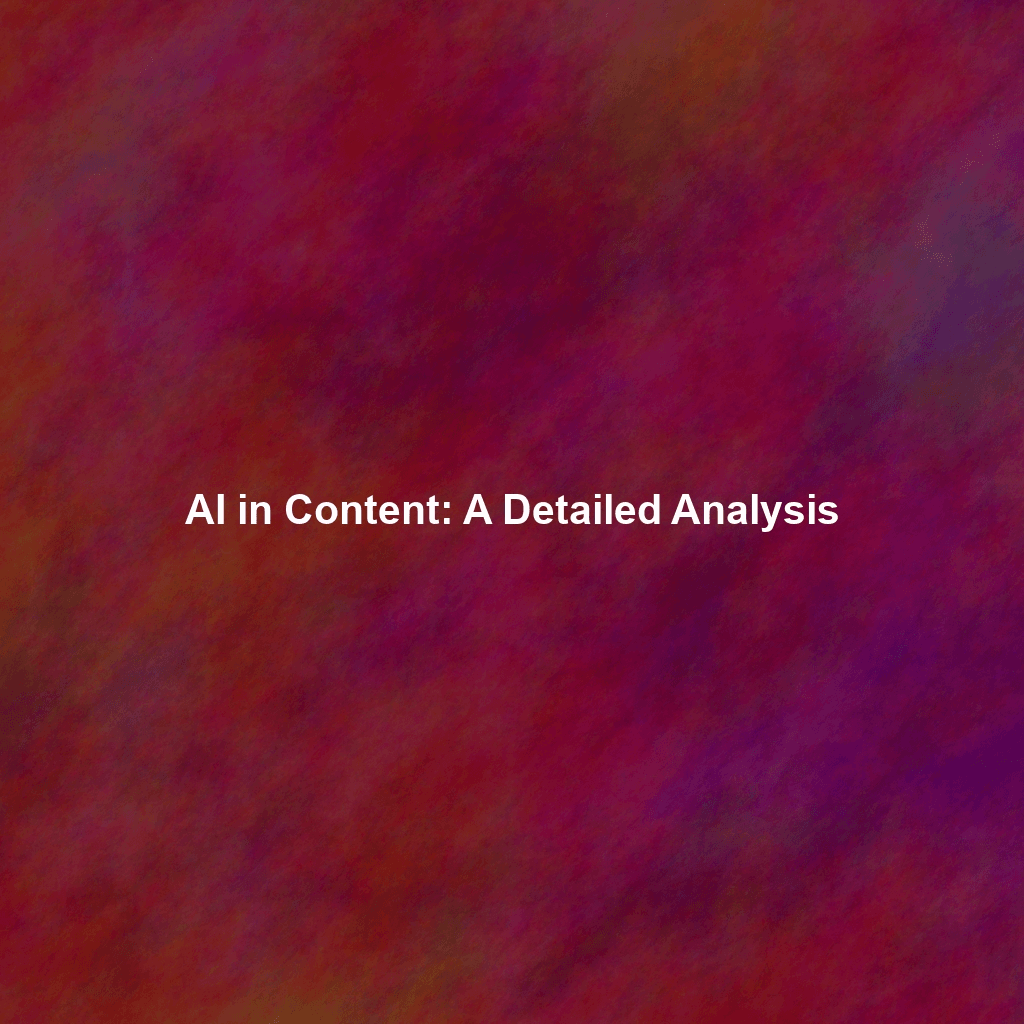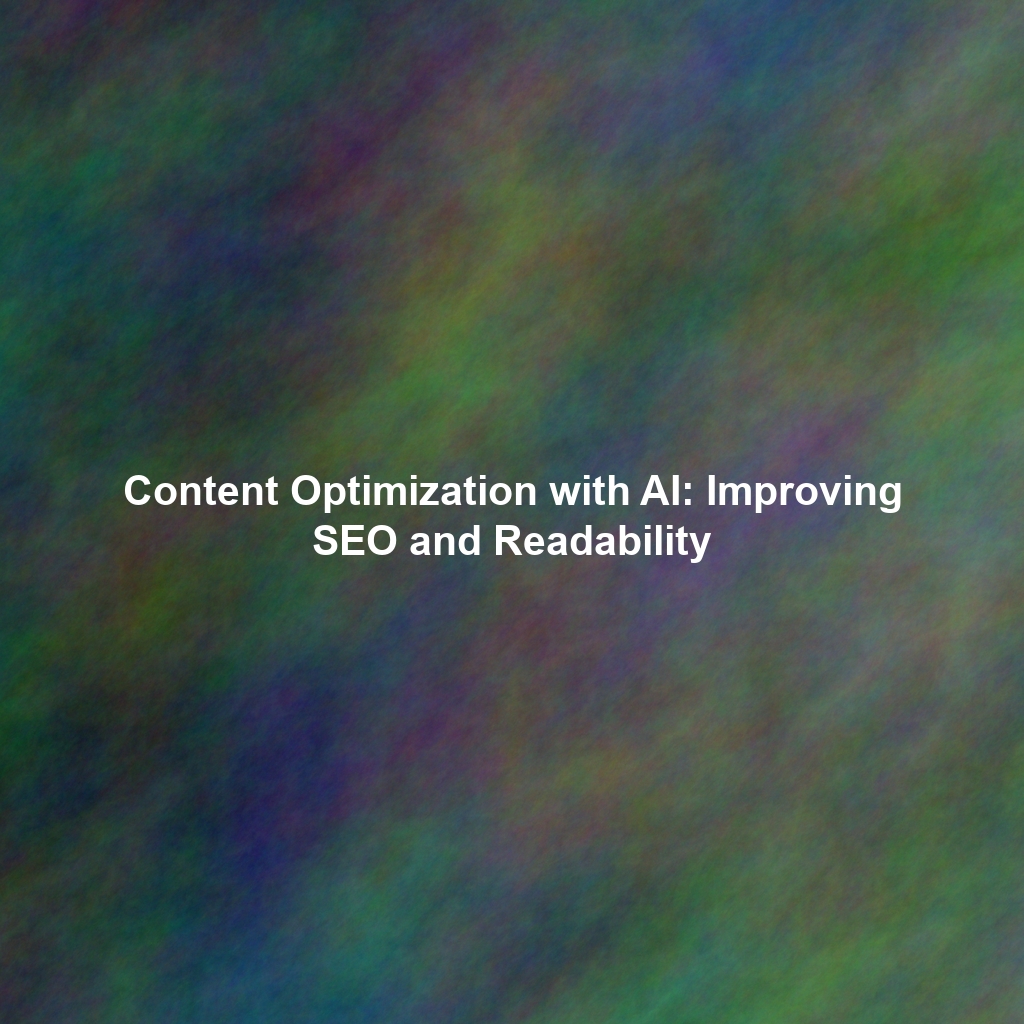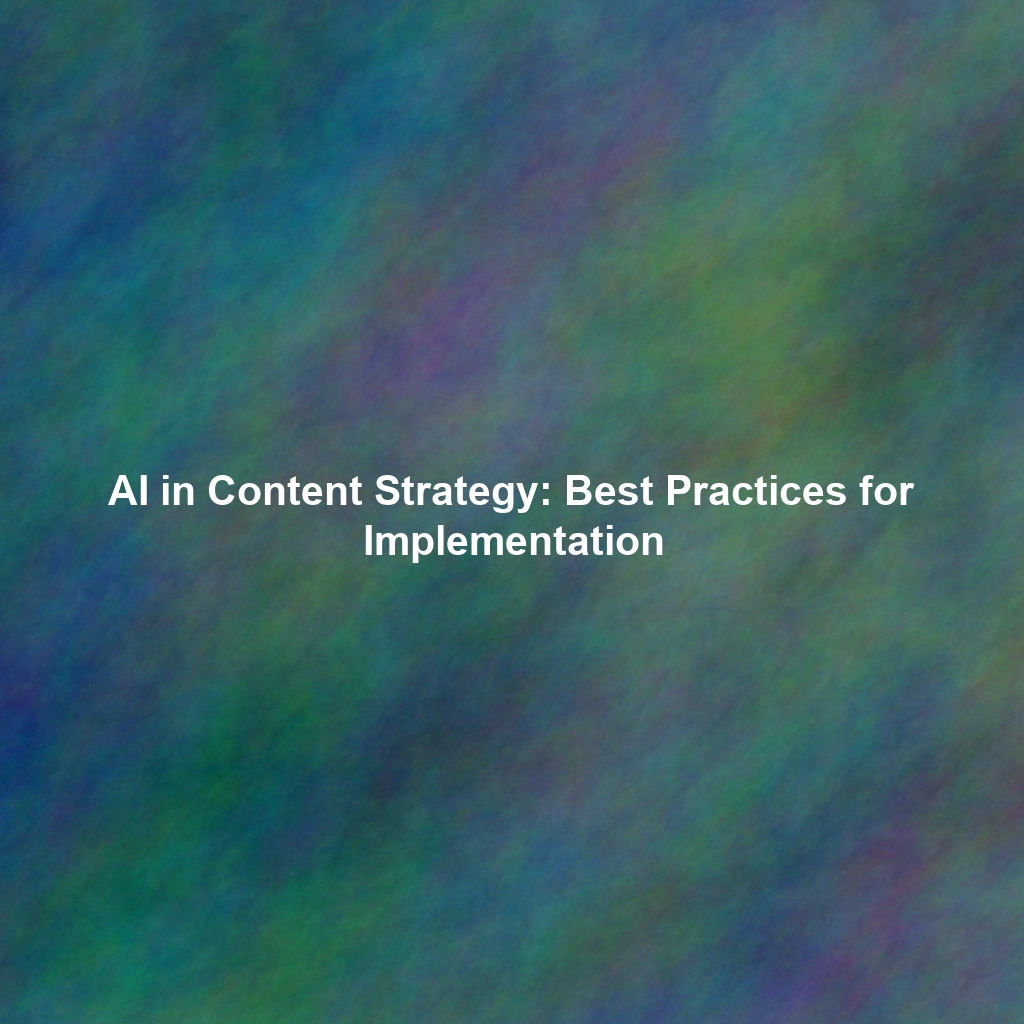Understanding AI’s Capabilities & Strategic Applications in Content Creation
Before diving into specific applications, it’s crucial to establish a clear understanding of AI’s current capabilities and inherent limitations within the content creation lifecycle. AI, particularly advancements in Natural Language Processing (NLP), Machine Learning (ML), and Generative AI, empowers tools to perform a wide array of tasks that enhance content operations:
- Text Generation & Draft Acceleration: AI can now generate original content based on precise prompts, keywords, outlines, or existing datasets. This includes drafting articles, blog posts, social media copy, email sequences, product descriptions, and even basic scripts. Tools like Jasper, Copy.ai, and Rytr excel at overcoming writer’s block and creating initial drafts, significantly accelerating the content production pipeline.
- Content Optimization & Performance Enhancement: AI analyzes content for critical performance metrics such as readability, SEO keyword density, semantic relevance, engagement potential, and even emotional tone. It provides actionable suggestions to improve content quality and discoverability.
- Advanced Keyword Research & Trend Identification: AI algorithms analyze vast amounts of search data, social media trends, and competitive landscapes to identify relevant, high-performing keywords, understand evolving search intent, and predict emerging topics. This allows for more targeted content strategies.
- Topic Ideation & Content Gap Analysis: AI can suggest potential content ideas based on trending topics, audience interests, and by performing sophisticated content gap analyses against competitors. This helps content strategists identify underserved areas and create more comprehensive content.
- Grammar, Style, and Tone Correction: Beyond basic spell-checking, AI tools offer sophisticated grammar correction, suggest improvements for sentence structure, clarity, conciseness, and even adjust content to a specific brand voice or desired tone.
- Multilingual Translation & Localization: AI-powered translation tools are evolving beyond simple word-for-word replacement, incorporating sentiment analysis and cultural context to ensure content resonates authentically with diverse linguistic and cultural markets.
- Hyper-Personalization & Recommendation Engines: AI can dynamically tailor content to individual user preferences, behaviors, demographics, and real-time interactions, delivering highly relevant experiences that increase engagement and conversions. Recommendation engines suggest relevant articles, products, or services based on user profiles.
- Content Summarization & Condensation: AI can efficiently condense long-form content into concise summaries, bullet points, or executive abstracts, making information more digestible and adaptable for various platforms.
- Content Repurposing & Format Transformation: AI can transform existing long-form content (e.g., a whitepaper) into various formats (e.g., blog posts, social media updates, video scripts, infographics outlines), maximizing the value of existing assets.
- Sentiment Analysis & Audience Insights: AI can analyze large volumes of text (e.g., customer reviews, social media comments) to gauge sentiment, identify common pain points, and uncover deeper audience insights that inform content strategy.
The Strategic Shift: From Manual to Augmented
The true power of AI in content creation isn’t about full automation, but about augmentation. It shifts the content creator’s role from manual execution to strategic oversight, creative direction, and critical refinement. This allows for increased output, enhanced quality, and more precise targeting, ultimately driving greater impact.
Acknowledging AI’s Current Limitations: Where Human Expertise Remains Indispensable
While AI’s capabilities are rapidly expanding, it’s critical for content strategists to acknowledge its current limitations. Over-reliance on AI without human oversight can lead to generic, inaccurate, or even problematic content. AI still struggles significantly with:
- True Creativity, Original Thought, and Nuance: AI primarily relies on patterns and existing data from its training set. This can lead to repetitive, generic, or formulaic content that lacks genuine originality, unique voice, or breakthrough ideas. It cannot yet replicate the spark of human ingenuity.
- Deep Nuance, Cultural Context, and Emotional Intelligence: AI can miss subtle undertones, complex cultural references, sarcasm, irony, and deep emotional cues. Content requiring profound empathy, subjective interpretation, or a nuanced understanding of human experience often falls short.
- Complex Reasoning, Critical Thinking, and Ethical Judgment: AI may struggle with tasks requiring advanced problem-solving, abstract thinking, moral reasoning, or navigating highly sensitive, ambiguous ethical dilemmas. It lacks inherent consciousness or a moral compass.
- Fact-Checking & Veracity: While AI can retrieve information, it often struggles with discerning factual accuracy, especially from unreliable sources. AI-generated content still requires rigorous human fact-checking to prevent the spread of misinformation.
- Maintaining a Unique Brand Voice: While AI can mimic a tone, consistently maintaining a truly unique, authentic, and evolving brand voice that resonates deeply with an audience still requires significant human input and refinement.
Therefore, AI should be viewed as a powerful co-pilot, not an autonomous driver. Human oversight, critical thinking, and creative direction remain indispensable for producing high-quality, impactful, and ethical content.
Core AI-Powered Content Creation Tools: A Deep Dive into the Ecosystem
The market is rapidly filling with AI writing tools, each promising to revolutionize content creation. While features and sophistication vary, most operate on similar principles, leveraging large language models (LLMs) and machine learning. Here’s a breakdown of common types and their strategic applications:
1. AI Content Generators (Generative AI)
These tools are designed to generate original content based on user prompts, keywords, or provided outlines. You input a topic, desired length, tone, and key points, and the AI produces a draft article, blog post, social media copy, email, or ad creative. Examples include Jasper (formerly Jarvis), Copy.ai, and Rytr. Their output quality heavily depends on the clarity, specificity, and detail of the input prompt. These tools excel at creating initial drafts, overcoming writer’s block, and generating variations for A/B testing. However, they often require significant human editing and refinement for factual accuracy, originality, and to infuse a unique brand voice.
2. AI Paraphrasing & Summarization Tools
These tools rewrite existing content to help avoid plagiarism, present information in a new way, or simplify complex language. They are useful for summarizing long articles, generating alternative headlines, or adapting content for different reading levels. QuillBot and Grammarly’s paraphrasing feature are popular examples. While highly helpful for avoiding direct duplication and improving conciseness, it is crucial to manually verify the accuracy, originality, and ethical implications of the rewritten content, especially when dealing with sensitive or factual information.
3. AI Grammar, Style, and Tone Checkers
These tools go far beyond basic spell-checking and grammar correction. They leverage AI to suggest sophisticated improvements for sentence structure, clarity, conciseness, and overall tone. Grammarly, ProWritingAid, and Hemingway Editor are widely used in this category. They significantly enhance content readability, professionalism, and consistency. However, content creators must use them judiciously; don’t blindly accept every suggestion. Writing style is often subjective and must ultimately align with a brand’s unique voice and strategic communication goals.
4. AI SEO Optimization Tools
These tools analyze content for SEO effectiveness, providing data-driven suggestions for keyword usage, meta descriptions, header optimization, internal linking, and overall readability. Platforms like Surfer SEO, SEMrush, and Ahrefs increasingly offer AI-powered features to help content rank higher in search results. While invaluable for identifying optimization opportunities and competitive gaps, remember that SEO is a multifaceted discipline requiring a holistic approach that includes high-quality, authoritative content, robust link building, and solid technical SEO. For a comprehensive guide to foundational SEO principles, Google’s own SEO Starter Guide remains an excellent, authoritative resource.
Leveraging AI for Advanced Content Optimization and Strategic SEO
Beyond direct writing assistance, AI plays a crucial, transformative role in optimizing existing content for search engines and enhancing overall content performance. This is where AI moves from a writing aid to a strategic intelligence tool.
- Precision Keyword Research and Intent Analysis: AI algorithms analyze vast amounts of search query data, conversational patterns, and user behavior to identify not just keywords, but the underlying *search intent*. This allows content creators to target the right keywords with content that precisely addresses user needs, significantly improving chances of ranking higher and driving relevant traffic.
- Sophisticated Content Gap Analysis & Topic Clustering: AI identifies nuanced gaps in your content strategy by analyzing competitor content, top-performing articles in your niche, and audience questions across various platforms. It helps identify topics your audience is interested in but are not yet comprehensively covered, enabling the creation of more comprehensive and valuable content clusters that establish topical authority.
- Readability Analysis & Audience Accessibility: AI assesses content readability using metrics like the Flesch-Kincaid reading ease score, Gunning Fog index, and other linguistic analyses. This ensures content is accessible and engaging for the target audience. Simplifying complex language, improving sentence structure, and adjusting vocabulary based on AI insights increases engagement and reduces bounce rates. For more on readability metrics and their psychological underpinnings, explore academic resources on psycholinguistics or educational assessment.
- Personalization and Dynamic Content Recommendation: AI personalizes content delivery based on individual user behavior, demographics, preferences, and past interactions. This allows for the delivery of tailored experiences—from personalized email content and dynamic website sections to customized product recommendations. This hyper-relevance significantly increases engagement, conversion rates, and customer satisfaction.
- Predictive Content Performance: AI can analyze historical data to predict which content formats, topics, or even distribution channels will resonate best with different audience segments. This allows marketers to proactively optimize their content strategies and create content that is more likely to attract, engage, and convert their target audience, reducing wasted effort.
- Automated Content Audits: AI can quickly review large content libraries to identify outdated information, broken links, duplicate content, or areas for SEO improvement, making content maintenance more efficient.
Ethical Considerations and Critical Challenges: Navigating the New Frontier
The rapid and widespread adoption of AI in content creation raises several profound ethical concerns and practical challenges that must be meticulously addressed by content creators and organizations:
- Plagiarism and Originality: The Integrity Question: AI-generated content can sometimes inadvertently plagiarize existing sources, especially if its training data isn’t properly vetted or if prompts are too close to existing material. It’s crucial for content creators to use robust plagiarism checkers and to carefully review all AI-generated content to ensure genuine originality and avoid copyright infringement. The responsibility for originality ultimately rests with the human creator.
- Bias and Fairness: The Algorithmic Imperative: AI algorithms are trained on vast datasets, which often reflect existing societal biases, stereotypes, or historical inequalities. If that data is biased, the AI will inevitably perpetuate and even amplify those biases in its output, leading to discriminatory, unfair, or unrepresentative content. Content creators must be acutely aware of potential biases in AI tools, rigorously audit their outputs, and take proactive steps to mitigate them. For comprehensive ethical AI guidelines, consider frameworks from organizations like IBM’s AI Ethics Principles or the European Commission’s Ethics Guidelines for Trustworthy AI.
- Transparency and Disclosure: Building Trust: There’s an ongoing, critical debate about the necessity and extent of disclosing AI-generated content to readers. While transparency can build trust and manage expectations, it can also lead to skepticism or perceived devaluation of the content. The decision depends heavily on context, audience expectations, and potential impact. Brands must weigh these factors carefully, prioritizing trust and ethical communication.
- Job Displacement & Evolution of Roles: The Human Element: Increased automation of content creation tasks raises legitimate concerns about job displacement for human writers and creators. While AI is highly unlikely to fully replace the need for human creativity, empathy, and strategic thinking, it will undoubtedly alter roles and responsibilities. Content creators must adapt, acquiring new skills that complement AI capabilities (e.g., prompt engineering, AI auditing, strategic oversight, ethical considerations).
- Copyright & Ownership: Legal Ambiguities: The legal landscape surrounding copyright and ownership of AI-generated content is still evolving and presents significant ambiguities. Brands must navigate these complexities, especially when using AI for commercial purposes.
- “Hallucinations” & Factual Errors: LLMs can sometimes “hallucinate” or generate plausible-sounding but factually incorrect information. This necessitates rigorous human fact-checking and editing for all AI-generated content, particularly in industries where accuracy is paramount (e.g., finance, healthcare).
Strategic Implementation: Integrating AI into Your Content Workflow
Successfully leveraging AI in content creation isn’t just about acquiring tools; it’s about strategically integrating them into your existing workflows and fostering a culture of augmented intelligence. This requires a phased, intentional approach:
- 1. Identify High-Impact Use Cases: Start by identifying specific, repetitive, or data-intensive tasks where AI can provide immediate value (e.g., generating social media captions, drafting email subject lines, summarizing long reports, initial keyword research).
- 2. Invest in Data Infrastructure: Ensure you have clean, structured, and accessible data to feed AI models. This might involve implementing a Customer Data Platform (CDP) or improving existing data governance.
- 3. Pilot Programs & Iteration: Launch small, controlled pilot programs to test AI tools and workflows. Meticulously track performance, gather feedback, and iterate based on results. This allows for learning and refinement before scaling.
- 4. Training & Upskilling Your Team: Provide comprehensive training for your content creators, marketers, and editors on how to effectively use AI tools, write effective prompts, audit AI output, and integrate AI into their creative process. Emphasize AI as an assistant, not a replacement.
- 5. Establish Clear Guidelines & Ethical Frameworks: Develop internal guidelines for AI usage, including policies on transparency, fact-checking, bias mitigation, and brand voice consistency.
- 6. Foster Cross-Functional Collaboration: Successful AI integration requires collaboration between marketing, IT, data science, and legal teams to ensure technical feasibility, data security, and compliance.
- 7. Continuous Monitoring & Optimization: AI models and their performance are not static. Continuously monitor AI-generated content performance, update models with new data, and refine prompts and workflows to ensure ongoing effectiveness and ethical compliance.
The Future of AI in Content Marketing: Beyond 2025 – A Collaborative Ecosystem
AI’s role in content marketing will only grow in sophistication and pervasiveness. Expect more advanced AI tools capable of generating higher-quality, more nuanced content, personalizing user experiences with unprecedented precision, and optimizing content strategies in real-time. The future may involve:
- Hyper-Personalized Content Journeys: AI will enable truly individualized content experiences, dynamically adapting entire content journeys based on unique user preferences, real-time behaviors, and emotional states.
- AI-Powered Content Curation & Discovery: AI will become even more adept at curating relevant and engaging content from vast sources, delivering customized content feeds and discovery experiences tailored to individual users.
- Automated Content Distribution & Optimization: AI will automate content distribution across an ever-growing array of channels, optimizing timing, messaging, and format for maximum impact and engagement based on predictive analytics.
- AI-Driven Content Analytics & Predictive Insights: AI will provide deeper, more predictive insights into content performance, identifying what resonates with specific audiences, forecasting future trends, and driving continuous improvement in content strategy.
- Virtual Content Assistants & Co-Creators: AI-powered virtual assistants will become integral co-creators, helping human creators with research, ideation, drafting, editing, optimization, and even multimedia generation (e.g., voiceovers, basic video edits), freeing them to focus on strategic and highly creative aspects.
- Synthetic Media & Immersive Experiences: AI will facilitate the creation of highly realistic synthetic media (images, video, audio) and power immersive content experiences in augmented reality (AR) and virtual reality (VR), offering new frontiers for personalized storytelling and brand engagement.
However, the human element remains crucially important. AI will be an increasingly powerful tool, but human content creators will continue to provide the creativity, empathy, critical thinking, ethical judgment, and unique perspective that AI currently lacks. Successful content strategies will not be about AI *replacing* humans, but about AI *augmenting* human expertise and insights, fostering a collaborative ecosystem where technology amplifies human potential.
Conclusion: Embracing AI as a Strategic Content Partner for the Future
AI is not a replacement for human creativity; it is a powerful, indispensable tool that augments and enhances every stage of content creation. By understanding its capabilities and limitations, and by addressing the critical ethical considerations, content creators and businesses can strategically leverage AI to improve efficiency, optimize performance, and deliver demonstrably more engaging and personalized experiences at scale. While challenges remain, AI’s potential benefits in content are undeniable and transformative.
The future of content creation lies in intelligent collaboration: humans and AI working together. This partnership will enable the creation of compelling, valuable, and ethical content that truly resonates with audiences and achieves ambitious business goals. Embrace AI as a strategic content partner, and your organization will be well-positioned to thrive in the rapidly evolving world of AI-powered content marketing, maintaining a competitive edge through augmented intelligence and unparalleled efficiency.
#AIinContent #ContentMarketing #AItools #DigitalMarketing #ContentStrategy #SEO #MarketingTech #FutureOfContent #ContentCreation #EthicalAI #GenerativeAI
 Skip to content
Skip to content

